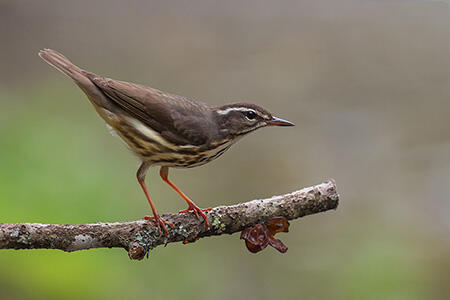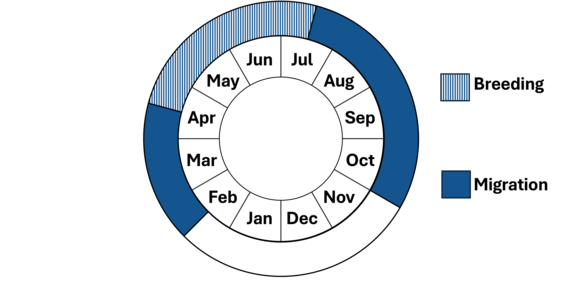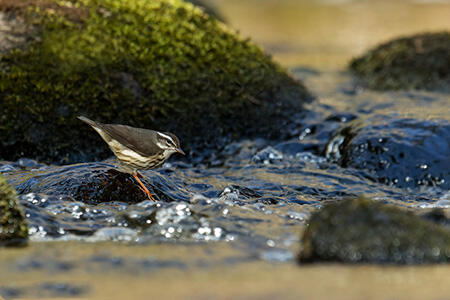- Scientific name: Seiurus motacilla
- Species of Greatest Conservation Need (MA State Wildlife Action Plan)
Description

The Louisiana waterthrush is a medium-sized (about 6 inches) migratory wood-warbler known more for its impressive vocal abilities and tail-wagging habit than for its drab coloration. Male and female plumages are similar and include a brown back, wings, and tail. The underparts are white with brown streaks. The head is brown with a white eye stripe and throat. Juvenile plumage is similar, but with rusty tips on tertials and distinct buff-colored wing-bars. Their primary song has a few clear introductory notes followed by several loud and complex phrases. Can be confused with the very similar looking northern waterthrush, a species that is generally found foraging in areas of stagnant water whereas the Louisiana waterthrush is associated with the flowing water of creeks and brooks.
Life cycle and behavior

The Louisiana waterthrush winters in Central America and the Caribbean and returns to its breeding grounds in Massachusetts in early to mid-April, migrating typically at night. Breeding occurs from late April to early July, with peak nesting activity in May and June. Pairs form monogamous bonds for the breeding season. Nests are typically placed in cavities or crevices along stream banks, concealed by vegetation, roots, or rocks. The female constructs the nest and lays four to six eggs, which she incubates for approximately 12-14 days. Both parents participate in feeding the nestlings, which fledge around 10 days after hatching but remain dependent on their parents for additional food and protection for several weeks. Following the breeding season, Louisiana waterthrushes undergo a complete molt before beginning their fall migration, which typically occurs between late July and early September.
Population status
The Louisiana waterthrush’s reliance on high-quality riparian habitats makes it vulnerable to habitat degradation and water pollution. Localized declines have been reported in areas where streamside forests are fragmented or degraded. The species is particularly sensitive to habitat disturbance, making it an indicator of stream health and water quality.
Distribution and abundance
The Louisiana waterthrush is an uncommon breeder in central and western Massachusetts but is rare east of Worcester County and absent from Cape Cod and the Islands. The species’ increased in Massachusetts between the two Breeding Bird Atlases, and its range is expanding north and east in northeastern North America, perhaps as a result of reforestation.
Habitat

Louisiana waterthrushes establish long (200-1,200 meters; 650-4000 ft), linear territories along flowing streams in continuous hardwood or mixed hardwood/conifer forests. They forage at fast rates in shallow water (< 2 cm; <0.8 in deep), using quick, jab-like strokes to capture aquatic insects and invertebrates. Nests are usually placed in cavities in vertical stream banks. A shallow cup is occasionally excavated in the cavity and then lined with leaves. The inside of the nest cup is constructed from fine plant materials including grasses, rootlets, fern material, and mosses. The nest is often located low on the bank, even within 15 cm (6 in) of running water.
Healthy habitats are vital for supporting native wildlife and plants. Explore habitats and learn about conservation and restoration in Massachusetts.
Threats
Habitat fragmentation is a potential threat as Louisiana waterthrushes are thought to be area-sensitive. Additionally, degradation of stream quality due to pollution, sedimentation, and deforestation reduces suitable nesting and foraging habitat. The species is particularly vulnerable to water contamination from agricultural runoff, pesticides, and changes in hydrology caused by human activities. Climate change may also pose long-term threats by altering stream flow patterns and impacting aquatic insect populations, a primary food source for the species.
Predation by domestic cats has been identified as the largest source of mortality for wild birds in the United States with the number of estimated mortalities exceeding 2 billion annually. Cats are especially a threat to those species that nest on or near the ground.
An additional threat to the species is collisions with buildings and other structures, as approximately 1 billion birds in the United States are estimated to die annually from building collisions. A high percentage of these collisions occur during the migratory periods when birds fly long distances between their wintering and breeding grounds. Light pollution exacerbates this threat for nocturnal migrants as it can disrupt their navigational capabilities and lure them into urban areas, increasing the risk of collisions or exhaustion from circling lit structures or areas.
Conservation
Maintaining and restoring riparian and floodplain habitat is critical to the conservation of Louisiana waterthrushes. Conservation efforts should focus on preventing streamside deforestation, erosion, and pollution, which can reduce habitat suitability. Protecting large, contiguous tracts of mature hardwood forests with minimal human disturbance is key to sustaining populations. Supporting “lights Out” programs in urban areas can help reduce mortalities associated with collisions with buildings during migration.
Promote responsible pet ownership that supports wildlife and pet health by keeping cats indoors and encouraging others to follow guidelines found at fishwildlife.org.
Bird collision mortalities can be minimized by making glass more visible to birds. This includes using bird-safe glass in new construction and retrofitting existing glass (e.g., screens, window decals) to make it bird-friendly and reducing artificial lighting around buildings (e.g., Lights Out Programs, utilizing down shielding lights) that attract birds during their nocturnal migration.
References
DeGraaf, R.M., & Yamasaki, M. (2001). New England Wildlife: Habitat, Natural History, and Distribution. Hanover, NH: University Press of New England.
Mattsson, B.J., & Cooper, R.J. (2009). Louisiana waterthrushes as bioindicators of riparian habitat quality: an assessment along a gradient of deforestation in the southeastern United States. The Condor, 111(4), 733-741.
Master, T.L., Mulvihill, R.S., & Robinson, W.D. (2020). Louisiana waterthrush (Parkesia motacilla), version 1.0. In Birds of the World (S.M. Billerman, B.K. Keeney, P.G. Rodewald, & T.S. Schulenberg, Eds.). Cornell Lab of Ornithology, Ithaca, NY.
Staudinger, M.D., et al. (2024). Climate change impacts on northeastern U.S. wildlife: Vulnerability assessments and adaptation strategies. Report to the Northeast Climate Adaptation Science Center.
National Audubon Society. Louisiana Waterthrush. Audubon Field Guide. Accessed 14 March 2025.
Walsh, J., and W. Petersen, editors. 2013. The Massachusetts Breeding Bird Atlas 2. Massachusetts Audubon Society. Scott & Nix, Inc. New York City, NY.
Contact
| Date published: | May 16, 2025 |
|---|